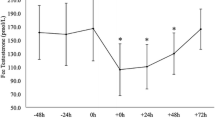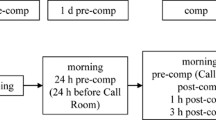Abstract
Cycling stage racing is a heavy and strenuous endurance event and it has been recognized that such exercise can affect the hormonal asset of hypothalamic–pituitary–adrenal (HPA) and hypothalamic–pituitary–testicular (HPT) axis. However, in cycling, literature on such changes is scarce and published data have been derived from small samples of athletes. The aims of study were to provide normative values for serum hormonal steroid values, changes in serum hormonal steroids and assess any relationships between a riders’ performance and their hormonal profile before and after the stage race. Male elite professional cyclists (n = 93) competing in the 2010 GiroBio 10-day stage race participated in this study. Blood chemistry measurements included cortisol (C), testosterone (T), free testosterone (fT) and sex hormone binding globulin (SHBG). Data are expressed as mean ± SD. Serum concentration of C and fT were lower at the end of GiroBio [C (nmol L−1): 559.34 ± 95.71 vs 469.59 ± 51.12; fT (pmol ml−1): 63.91 ± 27.85 vs 37.51 ± 17.86]. These serum hormonal (mean values ± 2SD) values may be near the physiological ceiling for elite cyclists. There was inverse correlation among average final speed and pre-competition serum concentration of T (r = −0.265, p = 0.01); average final speed was negatively correlated with riders body mass pre and post the 10-day stage event. In conclusion, pre-GiroBio serum C levels could be a useful benchmark to preserve riders’ health and, moreover, our data confirm that the strenuous effort sustained by riders during a stage race induces appreciable changes in the hormonal profile. In addition, our data suggest that lower levels of T could represent favourable prerequisite to cope better in a cycling stage race.
Similar content being viewed by others
References
Mujika I, Padilla S (2001) Physiological and performance characteristics of male professional road cyclists. Sports Med 31:479–487
Lombardi G, Lanteri P, Graziani R, Colombini A, Banfi G, Corsetti R (2012) Bone and energy metabolism parameters in professional cyclists during the Giro d’Italia 3-weeks stage race. PLoS One 7:e42077
Duclos M, Gouarne C, Bonnemaison D (2003) Acute and chronic effects of exercise on tissue sensitivity to glucocorticoids. J Appl Physiol 94:869–875
Duclos M, Corcuff JB, Arsac L, Moreau-Gaudry F, Rashedi M, Roger P, Tabarin A, Manier G (1998) Corticotroph axis sensitivity after exercise in endurance-trained athletes. Clin Endocrinol 48:493–501
Tremblay MS, Copeland JL, Van Helder W (2004) Effect of training status and exercise mode on endogenous steroid hormones in men. J Appl Physiol 96:531–539
Duclos M (2010) Glucocorticoids: a doping agent? Endocrinol Metab Clin North Am 39:107–126
World Anti Doping Agency (WADA) list of prohibited substances and method (2016). http://list.wada-ama.org/. Accessed 17 Aug 2016
Union Cicliste Internationale (UCI) medical rules (2015). http://www.uci.ch/clean-sport/rules-procedures/. Accessed 17 Aug 2016
Mouvement Pour un Cyclisme Crédible (MPPC)-internal rules (2016). http://www.mpcc.fr/images/internalrulesmars2016.pdf. Accessed 17 Aug 2016
Fédération Française de Cyclisme- reglement medical federal (2013). http://www.ffc.fr/wp-content/uploads/2015/11/Reglement-Medical-FFC-valide-CA-25_Janvier_2013.pdf?7496b0. Accessed 17 Aug 2016
Crewther BT, Cook C, Cardinale M, Weatherby RP, Lowe T (2011) Two emerging concepts for elite athletes: the short-term effects of testosterone and cortisol on the neuromuscular system and the dose-response training role of these endogenous hormones. Sports Med 41:103–123
Hackney AC, Moore AW, Brownlee KK (2005) Testosterone and endurance exercise: development of the ‘‘exercise-hypogonadal male condition”. Acta Physiol Hung 92:121–137
Adlercreutz H, Härkönen M, Kuoppasalmi K, Näveri H, Huhtaniemi I, Tikkanen H, Remes K, Dessypris A, Karvonen J (1986) Effect of training on plasma anabolic and catabolic steroid hormones and their response during physical exercise. Int J Sports Med 7:27–28
Hoogeveen AR, Zonderland ML (1996) Relationships between testosterone, cortisol and performance in professional cyclists. Int J Sports Med 17:423–428
Lucía A, Díaz B, Hoyos J (2001) Hormone levels of world class cyclists during the tour of Spain stage race. Br J Sports Med 35:424–430
Lombardi G, Lanteri P, Fiorella PL, Simonetto L, Impellizzeri FM, Bonifazi M, Banfi G, Locatelli M (2013) Comparison of the hematological profile of elite road cyclists during the 2010 and 2012 GiroBio 10-day stage races and relationships with final ranking. PLoS One 8:e63092
Harrison MH (1985) Effects on thermal stress and exercise on blood volume in humans. Physiol Rev 65:149–209
Bonifazi M, Sardella F, Lupo C (2000) Preparatory versus main competitions: differences in performances, lactate responses and pre-competition plasma cortisol concentrations in elite male swimmers. Eur J Appl Physiol 82:368–373
Campbell JE, Fediuc S, Hawke TJ, Riddell MC (2009) Endurance exercise training increases adipose tissue glucocorticoid exposure: adaptations that facilitate lipolysis. Metabolism 58:651–660
Viru A, Viru M (2004) Cortisol—essential adaptation hormone in exercise. Int J Sports Med 25:461–464
Grasso D, Corsetti R, Lanteri P, Di Bernardo C, Colombini A, Graziani R, Banfi G, Lombardi G (2015) Bone-muscle unit activity, salivary steroid hormones profile, and physical effort over a 3-week stage race. Scand J Med Sci Sports 25:70–80
Halson SL, Lancaster GI, Achten J, Gleeson M, Jeukendrup AE (2004) Effects of carbohydrate supplementation on performance and carbohydrate oxidation after intensified cycling training. J Appl Physiol 97:1245–1253
Bobbert T, Brechtel L, Mai K et al (2005) Adaptation of the hypothalamic-pituitary hormones during intensive endurance training. Clin Endocrinol 63:530–536
Wheeler GD, Wall SR, Belcastro AN, Cumming DC (1984) Reduced serum testosterone and prolactin levels in male distance runners. JAMA 4:514–516
Flynn MG, Pizza FX, Boone JB Jr, Andres FF, Michaud TA, Rodriguez-Zayas JR (1994) Indices of training stress during competitive running and swimming seasons. Int J Sports Med 15:21–26
Flynn MG, Pizza FX, Brolinson PG (1997) Hormonal responses to excessive training: influence of cross training. Int J Sports Med 18:191–196
Petroianu A, Veloso DF, Alberti LR, Figueiredo JA, Rodrigues FH (2010) Is there a relationship between physical performance and orchiectomy? Andrologia 42:302–304
Atwood CS, Bowen RL (2007) Metabolic clues regarding the enhanced performance of elite endurance athletes from orchiectomy-induced hormonal changes. Med Hypotheses 68:735–749
Georgieva KN, Boyadjiev NP (2004) Effects of nandrolone decanoate on VO2max, running economy, and endurance in rats. Med Sci Sports Exerc 36:1336–1341
Hartgens F, Kuipers H (2004) Effects of androgenic-anabolic steroids in athletes. Sports Med 34:513–554
Bonifazi M, Lupo C (1996) Differential effects of exercise on sex hormone-binding globulin and non-sex hormone-binding globulin-bound testosterone. Eur J Appl Physiol Occup Physiol 72:425–429
Antón MM, Izquierdo M, Ibáñez J, Asiain X, Mendiguchía J, Gorostiaga EM (2007) Flat and uphill climb time trial performance prediction in elite amateur cyclists. Int J Sports Med 28:306–313
Armstrong LE, VanHeest JL (2002) The unknown mechanism of the overtraining syndrome: clues from depression and psychoneuroimmunology. Sports Med 32:185–209
Halson SL, Jeukendrup AE (2004) Does overtraining exist? An analysis of overreaching and overtraining research. Sports Med 34:967–981
Urhausen A, Gabriel H, Kindermann W (1995) Blood hormones as markers of training stress and overtraining. Sports Med 20:251–276
Urhausen A, Kindermann W (2002) Diagnosis of overtraining: what tools do we have? Sports Med 32:95–102
Di Prampero PE (2000) Cycling on Earth, in space, on the Moon. Eur J Appl Physiol 82:345–360
Stovall K, Swain D, Debenedetti K, Pruitt A, Burke E (1993) Body mass and performance in the Tour du Pont. Med Sci Sports Exerc 25:S169
Faria EW, Parker DL, Faria IE (2005) The science of cycling: factors affecting performance—part 2. Sports Med 35:313–337
Swain D (1994) The influence of body mass in endurance bicycling. Med Sci Sports Exerc 26:58–63
Padilla S, Mujika I, Cuesta G, Goiriena JJ (1999) Level ground and uphill cycling ability in professional road cycling. Med Sci Sports Exerc 31:878–885
Author information
Authors and Affiliations
Corresponding author
Ethics declarations
Conflict of interest
The authors have no potential conflicts of interest that are directly relevant to the content of this paper.
Ethical approval
The study was carried out according to the ethical standards laid down in the 1975 declaration of Helsinki and was approved by Commissione Nazionale Tutela della Salute, Federazione Ciclistica Italiana, Roma, Italy and by Dipartimento per le politiche giovanili e le attività sportive - Presidenza del Consiglio dei Ministri, Roma, Italy.
Informed consent
Informed consent was obtained from all athletes included in this study.
Rights and permissions
About this article
Cite this article
Simonetto, L., Fiorella, P., Impellizzeri, F.M. et al. Testosterone and cortisol in 93 elite road cyclists during a 10-day stage race: relationship with final ranking. Sport Sci Health 12, 407–413 (2016). https://doi.org/10.1007/s11332-016-0306-9
Received:
Accepted:
Published:
Issue Date:
DOI: https://doi.org/10.1007/s11332-016-0306-9




